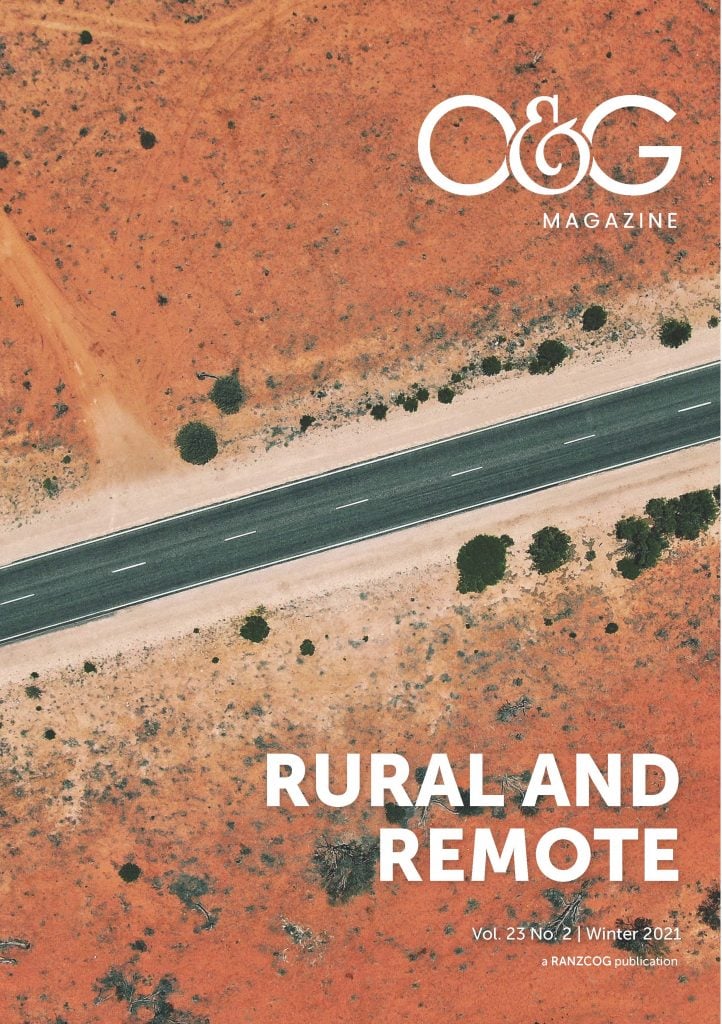Rural maternity service closure has been a consistent area of concern across the Australian health sector for several decades.1 During this time we have seen the centralisation of services from rural areas to regional and metropolitan settings with higher maternity capability, and the closure of rural maternity care which shapes not only health service provision but the fabric of rural communities.2
A variety of pressures are evident when examining the sustainability of rural maternity services. These include community demand, staffing, maternity care models and accessibility, with particular consideration for clinical skill and resources to meet capability requirements. Maternity services require streamlined communication pathways between health services, appropriate maternal assessment, and care planning.3
Every state and territory in Australia has a separate maternity service framework which guides health service executives in the allocation of resources, whilst in New Zealand, maternity care operates under the maternity standards which provide national directives for district health boards related to access of continuity of care from a lead maternity carer (LMC). These governance documents are quite different in structure, some are frameworks and others ministerial directives. There is varied consistency in application from country to country and jurisdiction to jurisdiction, and they have been produced in an effort to provide an overview of what is needed, to assure a safe and certain ability to deliver a set level of maternity care.
Time, effort, maternity consultation and commitment are required to rise to the challenge when assuring the viability of rural maternity services.4 These pressures are a reality for many organisations seeking to sustain and retain safe rural maternity services for women, however not insurmountable.5 A sense of rural health service pressure has seen the concept of maternity provision framed in the negative, as a risk, something that is too costly or dangerous.6 Whilst maternal wellbeing should be carefully assessed for appropriateness alongside service capability, this does not mean that birth is innately ‘risky’ or that rural maternity services should be considered ‘too hot to handle’. Rural maternity service closure may seem a simple option, but this notion is challenged when considering the immediate and long-term benefits rural maternity access has on women, families, and communities.7
Maternity governance
In the absence of a fully evaluated current Australian (national) maternity service capability framework, maternity services rely on markedly variable state and territory governance documents when assessing rural capability.8 9 Several Australian jurisdictions operate maternity capability under the auspice of clinical services, while others designate specific policy to maternity and neonatal capability. The lack of a formal network and communication strategy built into the majority of maternity capability policy is striking. To enable rural services to provide models of maternity care that are high quality and safe, expected referral pathways and network communication strategies should be mapped accordingly and embedded in policy documents.10
The flow-on effect for rural services who work to employ clear governance processes at ground level is that maternity services can be provided alongside a detailed understanding of how to best structure and plan maternity care in their own settings. The maternity service capability framework then becomes a complete and functional document which also instructs the expectation for higher capability receival services in support of ongoing rural maternity care.11 This in turn enables consistency in rural maternity operations and continuity for women across far reaching geographical ranges.
By comparison, New Zealand maternity standards provide operational policy that guides the development, funding, and evaluation of maternity services, which underpins primary maternity care and secondary services overseen by District Health Boards.12 The New Zealand maternity system is based in continuity of care, and as such LMCs, midwives or GP obstetricians, provide care for women.13
In rural areas self-employed midwives are the most common LMC, funded by a contract for service arrangement.14 A LMC midwife is supported by the guidelines for consultation with obstetric and related medical services which guide practice and referral. These guidelines are collaborative and agreed to by consumers, midwives, and obstetricians.15 The burden to retain LMCs to rural and remote areas in New Zealand is also an ongoing concern, with LMC payments largely based in intrapartum care. Referral from primary care to higher capability services leads to a loss of wage, additionally impacted by lower caseload opportunity in rural and remote areas. Whilst this pressure exists, the self determination of midwives as self-employed practitioners able to control and organise their own working environment appears to mitigate other pressures.
Rural connection to safety
Many rural clinicians recognise that communities are intertwined by generational bonds. Influence and narratives pass from family to family, or through community connection. There is a comfort and continuity for women and families in knowing who key maternity providers are, or simply knowing the health service history. The concept of continuity and consistency in maternity care spans beyond the pregnancy and birth continuum, it is the bedrock that forms trust in local health governance.16
The maternal and neonatal benefit of continuity of care has been evidenced.17 We understand women cared for by a known provider have better birth outcomes, less premature birth, and reduced anxiety associated with pregnancy and birth.18 To be known by a midwife or GP Obstetrician should not be underappreciated as an integral element of safety for women and babies in the rural sector.
A commitment to continuity in maternity care in the public health system, the sector most often accessed by rural women, requires an evaluation in the model of care, or structure of service, to best meet the needs of women. This may mean a normal-risk maternity service caring from pregnancy through to postpartum, care provided in the antenatal and postnatal period only, or a rural maternity service providing care as a satellite campus under the governance of an organisation with a higher level of maternity capability. Support for local health service executives to maintain rural service provision, with a clear communication and referral pathway enables a safe assurance of care, localised access for women to maternity care, and continuity rather than closure.
The budget
Closure of services simply means the transfer of pressure with ongoing impact on women and families. Factors such as financial costs and distress caused by travel and separation heighten the social risks experienced by rural families as a result of maternity service closure. Financial cost has been a common consideration by health service executives when considering the viability of their rural maternity services. Whilst budget constraints are an inevitable point of contention for rural health services, cost effective maternity models have been successfully adopted in rural Australia, with salaried midwifery group practice (MGP) options to effectively support maternity workforces.19
The great challenge for rural maternity services and their communities is operational expense versus long-term financial costs, often absorbed by maternal and child health, allied health or support services tasked with building maternal and family resilience after pregnancy, largely evidenced as emotional trauma.20 Rural maternity services have the opportunity to offset the potential for intrapartum transfer, roadside birth, or birth before arrival at hospital, by critically considering health service and community strengths or barriers when structuring a maternity service to meet women’s needs and provide women with a clear and agreed pathway of care.
Working as one
Rural midwives, nurses and GP’s often know each other outside their professional roles. Rural clinicians understand that women cannot afford disconnect between disciplines and deserve better. Improved networking amongst rural maternity clinicians has been reflected as a valuable support mechanism in retaining midwives in the rural sector.21 In this way, the strength of rural connection can be harnessed for the benefit of women. We need to reset our notions of what should be, consider what is, and what could be. Women seeing and hearing of birthing in local community strengthens community.
Birth knowledge shared between women is often framed in the negative; however, open relationships in rural communities can be the sharing of goodwill toward health services. It can also be the sharing of trust in establishments and with practitioners.22 Rural maternity services need to be part of conversations with their community and foster open and transparent discussions.
Pressure arising from rural communities to maintain maternity services will inevitably be the deciding factor for service longevity, but health service executives and boards must engage with people where they are and ensure the communities perspective is heard and valued. A defunct position is to offer public attendance in a health service setting. A far more viable option would be to meet with people in commonly occupied community spaces, such as library time, kindergarten, and schools. These are where health service executives will find women and families. This is where community response will be garnered, and women’s needs articulated. We have an opportunity to think laterally, restructure services, and develop network pathways that support and maintain maternity care as a valuable community service.
Let’s change the conversation, reframe the concept of risk, challenge centralisation, and change our thinking towards enhancing the safety of local rural services. For many women, rural services enhance care. Let’s stop perpetuating the idea that rural services are ‘risky’ and get busy sustaining safe options and access for rural women.
References
- Sweet L, Boon V, Brinkworth V, et al. Birthing in rural South Australia: The changing landscape over 20 years. Australian Journal of Rural Health. 2015;23(6):332-8.
- Kildea S, McGhie A, Gao Y, et al. Babies born before arrival to hospital and maternity unit closures in Queensland and Australia. 2015;28(3):236-45.
- Commonwealth of Australia. National maternity services capability framework. North Adelaide: Commonwealth of Australia; 2013.
- Toohill J, Chadha Y, Nowlan S. An interactive decision-making framework (i-DMF) to scale up maternity continuity of carer models. Journal of Research in Nursing. 2020;25(6-7):561-576.
- Durst M, Rolfe M, Longman J, et al. Local birthing services for rural women: Adaptation of a rural New South Wales maternity service. Australian Journal of Rural Health. 2016;24(6):385-91.
- Barclay L, Kornelsen J, Longman J, et al. Reconceptualising risk: Perceptions of risk in rural and remote maternity service planning. Midwifery. 2016;38:63-70.
- Lewis M, Passant L, Cooke H, Challis D. Women’s experiences of antenatal transfer for threatened premature labour in NSW: A qualitative study. Women and Birth. 2019;33(6):535-542.
- Victorian State Government. Capability frameworks for maternity and newborn services. Melbourne: Department of Health and Human Services.; 2019.
- Government of Western Australia. WA Health clinical services framework 2014-2024. Perth: Department of Health; 2015.
- Government of South Australia. Clinical services capability framework: Maternity and neonatal services. Adelaide: SA Health; 2015.
- New South Wales Government. NSW maternity and neonatal service capability framework. Sydney: NSW Health; 2016.
- Ministry of Health. New Zealand maternity standards: A set of standards to guide the planning, funding and monitoring of maternity services by the ministry of health and district health boards. Wellington: Ministry of Health; 2011.
- Ministry of Health. Section 88 primary maternity services notice 2007. New Zealand: Ministry of Health; 2007.
- Crowther S, Smythe L, Spence D. Unsettling moods in rural midwifery practice. Women and Birth. 2019;31(1):59-66.
- Ministry of Health. Guidelines for consultation with obstetric and related medical services (Referral Guidelines). Wellington: Ministry of Health; 2012.
- Crowther S, Smythe E. Open, trusting relationships underpin safety in rural maternity a hermeneutic phenomenology study. BMC Pregnancy and Childbirth. 2016;16(1):1-11.
- Sandall J, Soltani H, Gates S, et al. Midwife-led continuity models versus other models of care for childbearing women. The Cochrane Database of Systematic Reviews. 2016;4:CD004667.
- McLachlan H, McCourt C, Coxon K, Forster D. Midwifery Continuity of Care; Is midwifery continuity of care better for women and babies? What is the evidence? Chatswood: Elsevier Health Sciences; 2019. p. 1-20.
- Durst M, Rolfe M, Longman J, et al. Local birthing services for rural women: Adaptation of a rural New South Wales maternity service. Australian Journal of Rural Health. 2016;24(6):385-91.
- Priddis H, Keedle H, Dahlen H. The perfect storm of trauma: The experiences of women who have experienced birth trauma and subsequently accessed residential parenting services in Australia. Women and Birth. 2018;31(1):17-24.
- Daellenbach R, Davies L, Kensington M, et al. Rural midwifery practice in Aotearoa/New Zealand: Strengths, vulnerabilities, opportunities and challenges. New Zealand College of Midwives Journal. 2020;56.
- Crowther S, Smythe E. Open, trusting relationships underpin safety in rural maternity a hermeneutic phenomenology study. BMC Pregnancy and Childbirth. 2016;16(1):1-11.









Leave a Reply